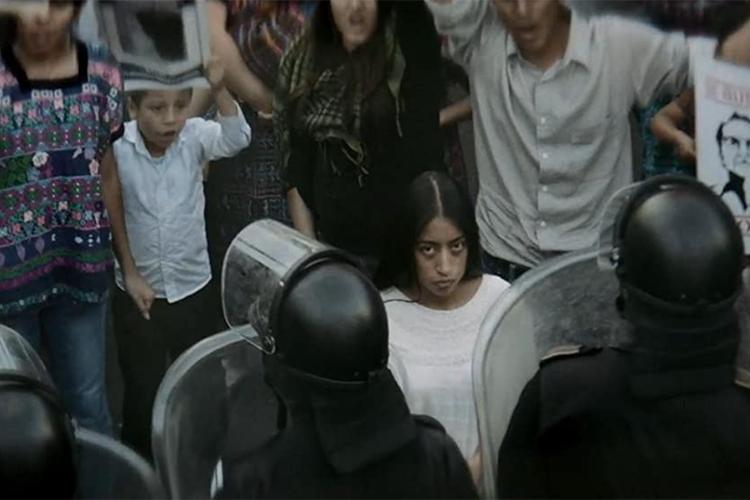The following questions and answers are excerpted from a conversation that followed the NBR screening of La Llorona.
Can you tell us about the evolution of this film?
Jayro Bustamante: Well, you know, at the beginning we were thinking about making a triptych, and that that triptych would be about three insults that are common in Guatemala and that people are accustomed to hearing all the time. And those insults, in my point of view, increase discrimination and separation between different circles of society. So the first of these insults is “indio,” and we know that in Guatemala that most of the population can trace their ancestry to indigenous peoples, the Mayan. It’s very… sad, to understand that for us, the product of our origin is something we are supposed to be ashamed of when we’re called “indio.” The second insult is “homosexual.” And it’s not only because we are a homophobic society, but it’s also intended to be an insult because they are essentially saying that if you are gay you are feminine, and therefore if you are feminine you are a lesser person. So at the end, the insult is towards all women as well. It’s very misogynistic. And the third insult is “communist.” And that insult is not about the fact that you’re part of a specific political ideology, it’s more coming from the 1950’s, when the United States had a lot of influence in Guatemala, and to be “communist” was to be the enemy. Even in the present day, it’s still a big insult to level at someone— it’s saying you’re an enemy of the state. Today, all the people who defend human rights, or social rights, or independent rights are called “communists.” So we wanted to talk about that third insult in La Llorona. The other two would have their own films. But in La Llorona we wanted to talk about that third insult. We were thinking about the fact that the world perceives a country that doesn’t respect human rights was finished by a genocide. So we started thinking about how to talk about that subject if my country doesn’t want to talk about it. And we made a kind study of which films Guatemalan’s were going to the theater to see. We found that they were consuming two main kinds: Superhero films, and horror films. So coming from that, we decided to use the legend of La Llorona as a way in. For us, La Llorona is a kind of cultural icon, and she comes from the horror universe. So it was very… I think very smart! To use that mythological character to talk about Guatemala’s recent history.
We ended up editing the film, which is not normal for a director and a producer
Gustavo, as a producer, how did you figure into the creation of the story, once you’ve decided to very intentionally make it accessible to a commercial market?
Gustavo Matheu: It’s something I really loved being involved with, because when Jayro invited me to collaborate originally, it was not only to work on films (which is obviously what I love), but it was also to use cinema as a tool to address issues in out country and in Latin America in general. And this was Jayro’s idea from the beginning. He did it with Ixcanul and with Tremors, and now with La Llorona. It’s not only about making films as a way of entertainment. For me, being involved in those projects that are not only aimed at making money in a theater, but are also intended to make people talk about things that are actually important, inspires me and makes want to be more involved in every aspect of the filmmaking process. And La Llorona was a film where we both got very very involved. We ended up editing the film, which is not normal for a director and a producer! But we knew the story, and we wanted to get it to the end. So we were very hands-on with the film the entire time. It was a beautiful experience and an honor.
How aware is the current generation about the atrocities that occurred in Guatemala?
JB: We wanted to talk about that in the film— we wanted to represent three different, or even four different generations in the film. And the generation represented by the character of Carmen, which is the generation that really lost the empathy for the suffering of all the Mayan people, of the victims, coming from the war. And I was thinking about the fact that this is a generation of people who lost that empathy, and how it would be appropriate if a ghost came to haunt them, to show them how the other people suffered. And the second generation is the one represented by Natalia in the film. And she’s kind of my generation— we really grew up with fear, and we’re still living with fear. So we have a lot of questions. And we start opening doors, but we don’t have the courage to go through them afterward. And the third generation is represented by the character of Sara. I don’t know if her generation will be like Natalia’s; I hope it won’t be. Maybe I’m unfairly putting the responsibility on that generation. But I think they will open and go through those doors, and they will look for answers. And the fourth generation — that I really like — is represented by Valeriana, the other Mayan who works in that house. And that’s the generation that has suffered the worst, because they are people who are living in those kinds of houses, serving those kinds of people, even if they know what those people have done and what they think. And in a way they are forced to love them and say ‘thank you’ anyway. So all of that is what we wanted to show in the film.

